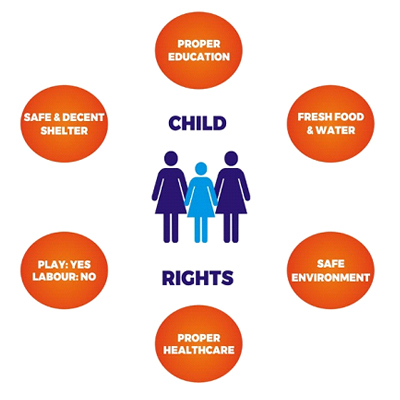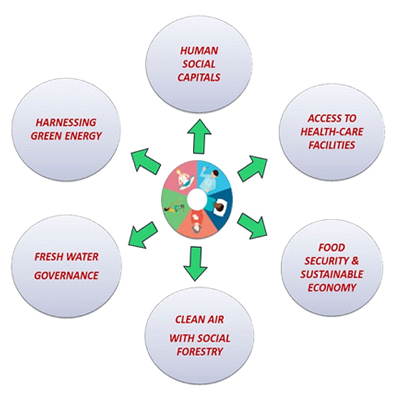‘Development and Justice can be achieved only when the Humanity is United and transformed into Welfare Citizenry’: As we know every citizen is endowed with some kind of talents and resources, yet they’re unable to unite or change their circumstances by their isolated efforts since they lack vital tools and skills, and that’s why the need for bringing diverse communities together on a shared vision with common goals – is the first step, then empower them adequately with tools and skills they lack so long, and transform their
individual talents into ‘Collectives of Social Capitals & Intelligence’, and the collectives of empowered citizens would resolve most of their challenges by themselves without recurrence external intervension…we strive to achieve these Goals with the following steps:
As Hunger & Health can’t wait for another day so to resolve both we begin empowering ‘Younger People’ with most relevant skills as they’re potentially more capable of lifting their communities out of their dire circumstances… are the primary objectives of Naihati New Life Society. Amara Sabai means ‘we are together’, and works among the most un-organized citizens with the mission to establish ‘Gender-just Sustainable Communities with Lasting Peace’ by raising Collectives of Citizens, supported by a time-tested Age-appropriate Inclusive Education Curricula called ‘Education Without Boundary’ – (EWB) that meets the needs of all citizens including who never had a formal education, enabling them to consistently re invent themselves, contribute whatever resources they’re endowed with, assume their rights to participate in decision-making process so as to ensure justice by themselves
‘Raising Community-based Dynamic Leaders of Character’: communities with as diverse as India are intently looking for ‘Dynamic Leaders with Accountability’. The leadership development curricula of ‘EWB’ helps in raising character-driven accountable leaders in each community who know the local context, to act as catalyst for peace, justice and carriers for development, mobilize communities against corruption, initiate re-distribution of wealth and monitor judicious use of natural resources according to the needs of citizens, and ensure decision-making power remains in the hands of common citizens (social justice) in order for the development to take root and sustain. Impacts of Climate Change with frequent natural calamities are a classic reminder of unmindful human actions that need interventions led by dynamic youth leaders with a whole community approach.
Mitigating the Factors & Forces that set the Paradigm: to make the development programs far more impactful, we need to mitigate the factors and forces that set the paradigm on which the challenges manifest. For example: inequality, child marriage and discrimination against women in society are just the manifestations of Indian age-old Caste System (Social Hierarchy) which is the ultimate product of the Religio-cultural Norms and Institutions as Factors and Forcesthat govern the communities and have broughtforth Casteism, resulting in persistent poverty, illiteracy and atrocities against women especially the ‘Dalits’ (lowest strata), for which a large section of women are unable to participate in socio-political decision-making process to claim their rights or contribute to the wellbeing of their families, therefore, it’s imperative to mitigate the factors and forces while working along with the members of elected body, leaders of community-based institutes law enforcement and judiciaries to end these discriminations, atrocities and persistent poverty.
‘Every Child as a Whole Person’ – physically, emotionally, intellectually and socially, therefore, children must be included into all intervention measurestaken for them as rights holders and agents of change as descrived in UN’s CRC. A special attention is needed to ensure the Safety & Development of Girl Children. For it’s proven that an extra year of girls’ education enables them to contribute more than 21% of their family needs, as it improves health and develops essential capacity in them to provide better care for babies, determine family size, reduce IMR, and eventually ends child marriage, violence and exploitations.
‘Initiatives for Youth Lifting Youth’: it’s essential to ensure healthy childhood devoid of socio-cultural ills, violence, fear and stigma so as to enable the children to learn the best virtues in life and relate themselves with all members of the communities and later become Healthy Youth – as the wealth of a nation! As we experience, these healthy youth lend their helping-hands to other children and youth deprieved of education or drop-outs irrespective of their gender, religion and colour. As a strategic approach, we adopt and enable families to create child-friendly environment so as to bring forth healthy children and youth with better care. We do train these healthy youth to become ‘Ambassadors of Peace’ and they in turn develop healthy relationship with larger communities, mitigate arttocities against children and women and mediate for intra-community peace and harmony.
‘Family-centred Health-care System under One Roof’: is essential without having to visit too many places to meet the critical health-care needs such as for chronic anaemia, paediatric tuberculosis, jaundice, malaria, stunting, thalassemia, HIV/AIDS (TMTC) etc especially in a hard to reach region where majority are illiterate, daily wage-earners and ignorant of the consequences of several of these unmet health-care needs, can certainly improve their daily living and reduce IMR & MMR along with other prevailing challenges. It’s also essential to develop a collaborative medical banking system involving all stake-holders of health products and service providers to ensure life-saving drugs are available at an affordable cost and with timely medical intervention.
‘Inclusive Planning for Poverty Alleviation & Local Economic Development’- (LED): the initiatives must be Contextual, Environment Friendly, Sustainable, Far-sighted, using Local Resources and capable to mitigate Geo-specific Challenges… turning every adversity into opportunity. For, places like the islands of Sundarbans with no industry, fully surrounded by Saline-water, extremely vulnerable to natural calamities, where Youth including housewives as vital Local Resoures who otherwise unsustainably exploit Coastal Resources posing serious threat to Mangroves Foresty which is again the vital source for Alternative Livelihood, Shelter for fish-breeding and Protector for Soil erosion and Tidal flooding. Therefore, developing skills for Advanced Agricultural practices, Animal husbandary, Pisci culture etc within the Ecological Risk Management, can meaningfully dissuade them, and re-engage them and inculcate a spirit of entrepreneurship in them which will multiply the opportunities in many ways. New markets can emerge to market their products, their improved purchasing capacity can increase their accessibility to financial institutes and also can pave the way for further investments and trading, in addition to the Restoration of the vital Coastal Ecology, which is also an essential ‘Disaster Risk Reduction Initiative’ – (DRRI).
– Dr. Arup Karali (SME & Chief Consultant @ Naihati New Life Society)

